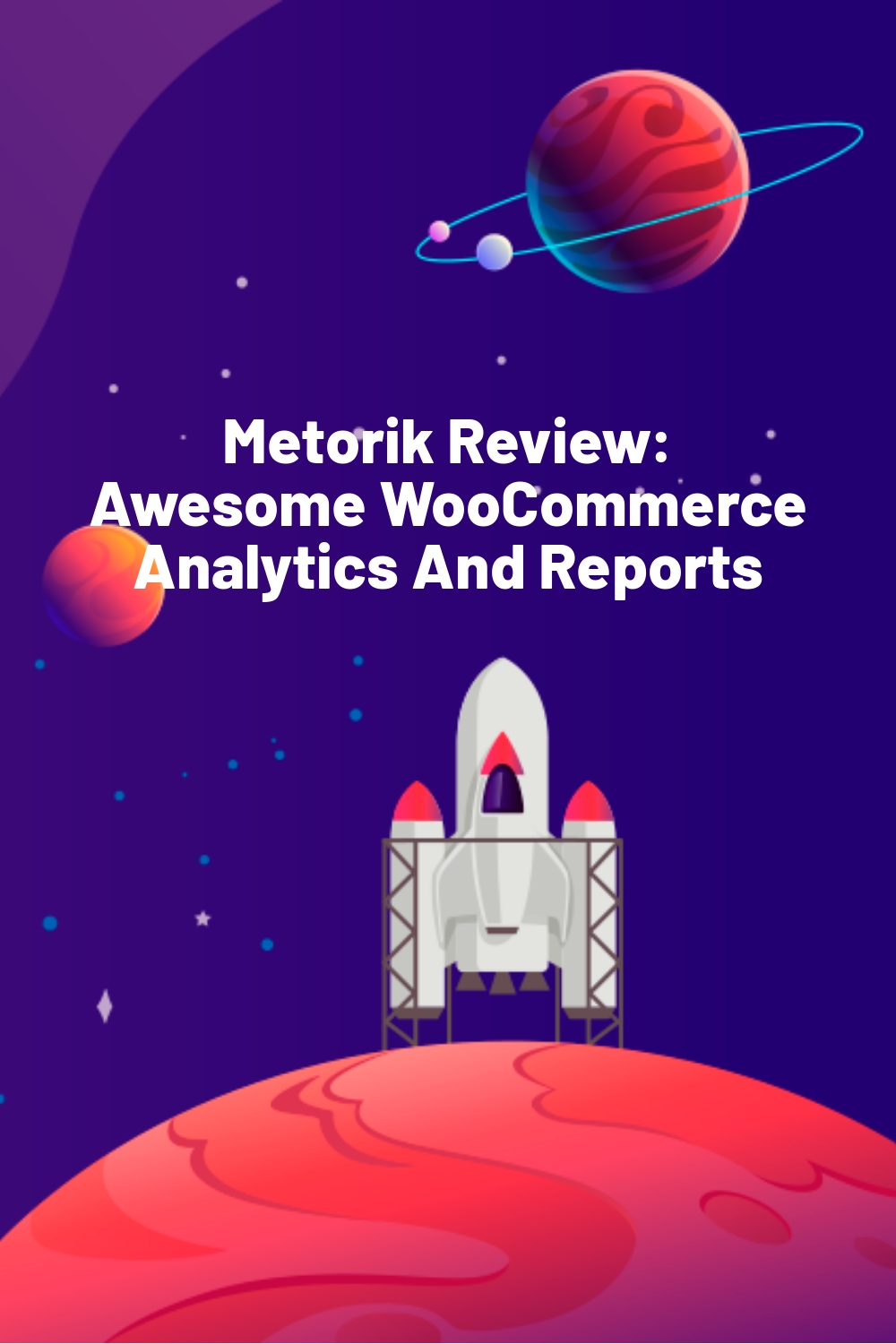WPLift is supported by its audience. When you purchase through links on our site, we may earn an affiliate commission.
Metorik Review: Awesome WooCommerce Analytics And Reports
If you run an eCommerce store, you need data. It tells you who your most valuable customers are, what products perform the best, how your vital signs are doing, and lots more. More than needing data, you need that data to be in a format that you can quickly access and actually apply to making your store better. By default, though, WooCommerce’s reporting features leave a lot to be desired. Metorik, a service built by a former Automattic engineer who actually worked on the WooCommerce core, changes that. In this Metorik review, we’ll show you more about how this tool functions. If you’re running an eCommerce store on WooCommerce, you should absolutely read this review and consider using Metorik at your store.
Already hyped? Check out Metorik right away.
Metorik

Metorik adds cloud-based reporting and analytics for your store that makes your data more flexible. In addition to that, it gives you deep control over segmentation. Excluding the beautiful and clean interface, it gives you full access to everything, easily. The reports are more detailed which makes it easier to find KPI, especially if you’re a store owner.
Metorik’s pricing is based on the number of monthly orders at your store. Beyond that, there are no feature restrictions between the different plans. Pricing starts at $20 per month for up to 100 orders per month and goes up from there. You can also get 2 months free if you pay annually.

If you’re running multiple stores, you’ll like that you can use unlimited stores with a single subscription (you just pay based on the combined monthly orders of all your stores).
To calculate your monthly orders, Metorik uses the average of your past 3 months.
Metorik Key Features
First off, Metorik plainly offers a much nicer interface to work in than the regular WooCommerce interface. The clunky reports are gone, replaced by a well-designed cloud interface:

But style doesn’t mean anything without substance. And substance is where we think Metorik really excels.
It makes it easy to:
- Understand high-level data about your store’s general performance
- Compare dates to view trends
- Create customer segments
- Generate meaningful insights about product performance
- Predict the future
And beyond reports and analytics, Metorik can also help you:
- Manage orders and customer details
- Connect to some popular customer service tools to offer better support
- Connect to email marketing tools for easier marketing (tied to Metorik’s segmentation features, this is super powerful)
And if you’re plagued by a slow WordPress admin dashboard at your store, you’ll love that Metorik isn’t constrained by your WordPress site’s database. This usually means much faster– loading reports, especially if you’re running a busy store with lots of products.
Pros
- Ideal for big sale stores as they don’t need to wait for reports
- Well-thought user interface and ease of use. You don’t need to be technical to be able to use this plugin.
Cons
- The pricing plan is based on the number of orders, therefore it can be pricey in the long run especially for bigger stores.
Metorik Installation & Setup
Setting Your Store Up With Metorik
Setting up your store at Metorik is super simple. It has one of the slickest implementations that I’ve seen.
All you do is enter your store’s name and URL:

Then, Metorik will ask for permission to connect via the WooCommerce API. Once that’s done, all you need to do is install the Metorik Helper plugin (which Metorik links you right to – very nice onboarding).
Once you install the helper plugin, Metorik will start importing your store’s data. While that happens, it will give you a nice little setup wizard to configure some basic facts and settings for your store:

You can also:
- Add other team members (including user roles to restrict what permissions users have)
- Set up email digests (more on these later)
- Connect to other services
All in all, the onboarding process is great and, to be honest, miles above what most WordPress plugins do.
A Quick Tour Of The Metorik Dashboard
When you first land in the Metorik dashboard, Metorik gives you an overview of all your important information and KPIs.
At the top, you can see basic information about your store and an activity feed:

And below that, you get a list of all your important KPIs:

There are two things that I think are really helpful with the dashboard.
First, Metorik lets you easily compare your numbers to any other time period to quickly figure out how your store is trending. If you’re familiar with this feature in Google Analytics, the functionality and implementation are almost identical:

Second, the dashboard is fully customizable. If you click the Customize button, you’ll be able to edit every element on your dashboard and add/remove “cards” (cards are essentially reported data):

You can even create multiple dashboard screens so that you can quickly switch between views to find the most relevant information:

This feature is kind of like creating a custom dashboard in Google Analytics.
Pre-built Reports For Quick Access To Important Data
Beyond your dashboard, Metorik also includes a number of pre-built reports that span:
- Revenue – lets you see revenue over time, as well as a breakdown to see how much you’re paying in taxes, shipping, fees, refunds, etc.
- Orders – lets you see the orders that are bringing you that revenue, as well as a breakdown by new vs. existing customers.
- Refunds – lets you view your refund rate, as well as some other details about product refunds.
- Devices – lets you see which devices and browsers your customers use the most.
- Sources – lets you see orders and sales by referring site.
- Forecast – this is a cool one that gives you a sales projection going forward based on your data. Helpful for planning. You can choose between exponential or linear growth, as well as factor in your own numbers for monthly growth.
- Customers – lets you see information about your customers like where they come from and where they ship items, as well as the lifetime value of a customer.
- Customer Retention – lets you see how effective you are at turning one-time customers into repeat customers. You can also see previously high-value customers that haven’t made a purchase in 30 days, which is helpful for marketing.
- Product Comparison – lets you see which products perform the best and compare products against one another.

Beyond just plain giving you a ton of data, here’s the truly nice thing about these reports:
The data is actionable. Having “data” doesn’t mean anything if you can’t put it to use to actually improve your bottom line. Metorik does a great job of making that easy. And like your dashboard, you can also compare any of these reports against a different time period to see how things have changed over time.
We couldn’t show you screenshots of all the reports, but if you want to see them in action, head here and scroll to the What’s covered? section.
Order, Customer, Product, And Coupon Management + Segmentation
Here’s where Metorik starts getting really cool. It includes separate sections that let you manage your:
- Orders
- Customers
- Products
- Coupons
For example, if you go to Orders, you’ll see a list of all of your orders:

That’s not the really cool part – you can already do that from your WooCommerce dashboard.
Here’s the really cool part:
For all of these areas, you can create incredibly detailed segments using and/or conditions and Metorik will automatically update the list with no page reload required.:

This helps you not only better understand your store and patterns, but you can also use it in your marketing efforts because Metorik makes it easy to export the data from your segments.
And you can also save any of the segments you create to easily pull them up later on.
Email Digests For Easy Access
If you’re a busy person, you might not want to dig into your full reporting dashboard every day. But it’s still important that you keep track of your basic KPIs to stay on top of things.
Metorik’s Digests feature helps you balance those two goals by letting you automatically send yourself your most important metrics via email or Slack.
You can choose from two different digests:
- General – includes key KPIs for your overall store.
- Products – shows the top products from that time period.
What we like about it is that the digests are written in plain English, which makes it really easy to understand how your store is doing:

Verdict
We’ve used Metorik before writing this review, but we are still always impressed by how polished a product it is.
We love WordPress…but oftentimes there’s a noticeable gap between the quality of a plugin’s interface and the quality that you’d get with a SaaS tool.
Metorik feels like a SaaS tool rather than a plugin (which it kind of is because of how it uses the WooCommerce API).
The interface not only looks great, it’s also significantly faster-loading than your WordPress dashboard and makes it much easier to access actionable data in comparison to the default WooCommerce reports.
The segmentation feature is powerful and deep. And Metorik’s integrations make it easy to connect your data and segments to help with customer support or marketing.
If you run a WooCommerce store, we definitely think you should at least try this tool. Metorik offers a free 30-day trial with no credit card required, so you’re not risking a thing.








